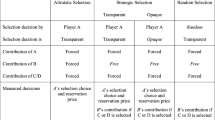Abstract
Political influence by a professional association, like the influence of any special interest group, is a collective good for the members of the profession. This paper investigates the variables affecting the ability of state optometric associations to overcome the free rider problem and induce optometrists to join the association. Although the empirical results show little evidence that organization costs are reduced by concentration in urban areas, the results do strongly support the hypothesis that there will be less free riding in smaller groups. The results also support the hypothesis that selective incentives enable latent groups to overcome the free rider problem. By providing continuing education at reduced fees to members of the association, optometric associations have increased the percentage of optometrists who are association members in those states with statutory continuing education requirements.
Similar content being viewed by others
References
American Optometric Association. (1986). AOA membership report, Jan. 1970 – Jan. 1986. St. Louis, MO.
Becker, G.B. (1983). An examination of the capture theory of regulation: The development of a general empirical model and its application in two cases. Unpublished doctoral dissertation. Boston College.
Becker, G. (1986). The public interest hypothesis revisited: A new test of Peltzman's theory of regulation. Public Choice 49 (3): 223–234.
Blue book of optometrists. (1974). Chicago: Professional Press, Inc.
Kilbane, S.C. (1987), Changes in medical licensure laws — the case of optometry: An economic analysis within the Stigler-Peltzman framework. Unpublished doctoral dissertation. Case Western Reserve University, Cleveland.
Moore, T.G. (1961). The purpose of licensing. Journal of Law and Economics 4 (October): 93–117.
Olson, M. (1971). The logic of collective action. Cambridge: Harvard University Press.
Oster, S.M. (1980). An analysis of some causes of interstate differences in consumer regulations. Economic Inquiry 18 (January): 39–54.
Posner, R.A. (1974). Theories of economic regulation. Bell Journal of Economics 5 (Autumn): 335–357.
Stigler, G.J. (1975). The theory of economic regulation. In G.J. Stigler, The citizen and the state, 114–141. Chicago: University of Chicago Press.
Weingast, B.R. (1981). Regulation, reregulation, and deregulation: The political foundation of the agency clientele relationships. Law and Contemporary Problems 44: 147–177.
Author information
Authors and Affiliations
Rights and permissions
About this article
Cite this article
Kilbane, S.C., Beck, J.H. Professional associations and the free rider problem: The case of optometry. Public Choice 65, 181–187 (1990). https://doi.org/10.1007/BF00123798
Issue Date:
DOI: https://doi.org/10.1007/BF00123798




